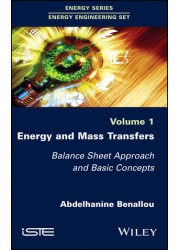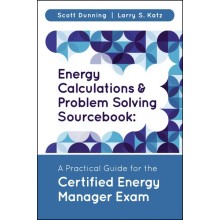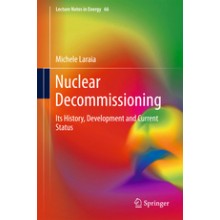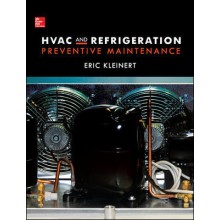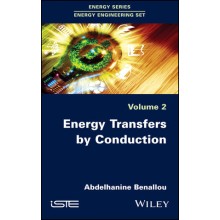Energy and Mass Transfers: Balance Sheet Approach and Basic Concepts, Volume 1: 2018
Quantity:
-
Add to Compare
This is the first book of a series aiming at setting the basics for energy engineering. This book presents the fundamentals of heat and mass transfer with a step-by-step approach, based on material and energy balances.
While the topic of heat and mass transfer is an old subject, the way the book introduces the concepts, linking them strongly to the real world and to the present concerns, is particular. The scope of the different developments keeps in mind a practical energy engineering view.
Preface ix
Introduction xiii
Chapter 1. Basic Concepts and Balances 1
1.1. Thermal energy and the first law of thermodynamics 1
1.2. Thermal energy and the second law of thermodynamics 2
1.3. For an energy and mass accounting: balances 3
1.3.1. Accounting principles for system inputs and outputs 4
1.3.2. Accumulation in the system 8
1.3.3. Generation in a system 11
1.3.4. Balance equation 15
1.4. Fluxes and flux densities 20
1.4.1. Energy fluxes 20
1.4.2. Mass fluxes 20
1.4.3. Flux densities 20
1.5. Operating states 25
1.5.1. Steady state 25
1.5.2. Transient state 25
1.6. Transfer area 28
1.6.1. What does the transfer area represent? 28
1.6.2. Illustration: transfer area in a heat exchanger 28
1.6.3. Illustration: transfer area inferred from a technical drawing 30
1.7. Driving potential difference 31
1.7.1. Heat transfer potential difference 32
1.7.2. Mass transfer potential difference 34
1.8. Exercises and solutions 38
1.9. Reading: seawater desalination 75
1.9.1. Level of purification 75
1.9.2. Water sources used 76
1.9.3. Water characteristics according to the source 76
1.9.4. Several techniques 76
1.9.5. Energy cost: the decisive factor 76
1.9.6. A promising outlook 77
Chapter 2. Mechanisms and Laws of Heat Transfer 79
2.1. Introduction 79
2.2. Mechanism and law of conduction 79
2.3. Mechanism and law of convection 83
2.3.1. Examples 83
2.3.2. Law of convection 84
2.3.3. Forced convection versus natural convection 84
2.4. Radiation transfer mechanism 85
2.4.1. Correction to take account of the nature of the surface 87
2.4.2. Geometric correction: the view factor 87
2.4.3. Radiation transfer between black surfaces under total influence 89
2.4.4. Radiation transfer between black surfaces in arbitrary positions 90
2.4.5. Radiation transfer between gray surfaces in arbitrary positions 91
2.5. Exercises and solutions 92
2.6. Reading: Joseph Fourier 112
Chapter 3. Mass Transfer Mechanisms and Processes 115
3.1. Introduction 115
3.2. Classification of mass transfer mechanisms 116
3.3. Transfer mechanisms in single-phase systems 117
3.3.1. The vacancy mechanism 117
3.3.2. The interstitial mechanism 118
3.3.3. Random walk 118
3.3.4. The kinetic model 118
3.3.5. The quantum model 120
3.4. Mass transfer processes in single-phase media 122
3.4.1. Transfer under the action of a concentration gradient: osmosis 122
3.4.2. Transfer under the action of a pressure gradient: ultrafiltration 127
3.4.3. Dialysis 134
3.4.4. Thermal gradient diffusion 139
3.4.5. Diffusion by a gradient of force: centrifugation 141
3.4.6. Electromagnetic diffusion 143
3.4.7. Laminar flux transfer 144
3.4.8. Laser transfer 145
3.4.9. Transfer under the action of an electric field: electrodialysis 146
3.5. Mechanisms and processes in two-phase media 154
3.5.1. Distillation 154
3.5.2. Absorption mass transfer 165
3.6. Exercises and solutions 176
3.7. Reading: uranium enrichment 217
3.7.1. Uranium as a fuel 217
3.7.2. Uranium in nature 217
3.7.3. Natural-uranium reactors 217
3.7.4. Pressurized-water reactors 218
3.7.5. Fast-neutron reactors 218
3.7.6. Classification of uranium enrichments 218
3.7.7. Uranium enrichment processes 219
3.7.8. The uranium enrichment industry 219
Chapter 4. Dimensional Analysis 221
4.1. Introduction 221
4.2. Basic dimensions 222
4.3. Dimensions of derived magnitudes 222
4.4. Dimensional analysis of an expression 225
4.4.1. Illustration: determining the dimensions of λ 225
4.4.2. Illustration: determining the dimensions of h 225
4.5. Unit systems and conversions 226
4.5.1. Illustration: dimensions and units of energy 227
4.5.2. Illustration: units of heat conductivity λ 227
4.5.3. Illustration: units of the convective transfer coefficient h 228
4.6. Dimensionless numbers 229
4.6.1. The Reynolds number 230
4.6.2. The Nusselt number 231
4.6.3. The Prandtl number 231
4.6.4. The Peclet number 231
4.6.5. The Grashof number 232
4.6.6. The Rayleigh number 233
4.6.7. The Stanton number 233
4.6.8. The Graetz number 234
4.6.9. The Biot number 234
4.6.10. The Fourier number 234
4.6.11. The Elenbaas number 235
4.6.12. The Froude number 235
4.6.13. The Euler number 236
4.7. Developing correlations through dimensional analysis 239
4.8. Rayleigh’s method 241
4.8.1. Illustration: applying Rayleigh’s method 242
4.8.2. Illustration: verifying Fourier’s law by applying Rayleigh’s method 245
4.9. Buckingham’s method 247
4.9.1. Illustration: applying the Buckingham π theorem 248
4.10. Exercises and solutions 251
4.11. Reading: Osborne Reynolds and Ludwig Prandtl 294
4.11.1. Osborne Reynolds 294
4.11.2. Ludwig Prandtl 296
Appendix 299
Bibliography 315
Index 325
Write a review
Your Name:Your Review: Note: HTML is not translated!
Rating: Bad Good
Enter the code in the box below:
Copyright © 2014 Engineering Standards Bureau. All Rights Reserved.
Developed By Zoom Into Web


